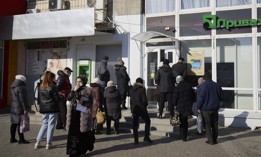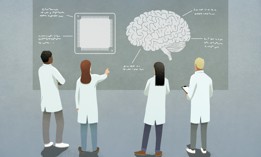Anti-Surveillance Camouflage for Your Face

Mega Pixel/Shutterstock.com
A special make-up can keep facial-recognition algorithms from detecting a face.
The NSA made me slather my face in make-up.
Or, it didn’t make me, exactly. But last spring, I found myself wandering around D.C., wearing dazzle camouflage for the first time. It was a sunny Saturday, the capital swamp neither frigid nor muggy-oppressive—perfect for walking. It took me 45 minutes to get all the makeup on, to get the pencil right and the hair dangled just so.
I spent the day hanging out with some friends around Adams Morgan, a neighborhood seemingly developed by former hippies who had gone into non-profit C-suites or opened boutique restaurant-bars. I told my friends why my face had splotches of dark makeup on it but didn’t say much to anyone else, and that’s when the looks began.

I should step back. I had slathered the paint on my face in order to hide from computers. The patterns in which I applied the paint were important: To the pixel-calculating machinations of facial recognition algorithms, they transformed my face into a mess of unremarkable pixels. In the computer’s vision, my face caused a momentary burst of confusion.
That’s why the patterns are called computer vision dazzle (or CV dazzle). When it works, CV dazzle keeps facial-recognition algorithms from seeing a face. The technique takes its name from the dazzle camouflage of the two World Wars: The Great Power navies sought to protect their ships not by hiding them among the waves but by obscuring their size and movement. CV dazzle was developed by the artist, designer, and entrepreneur, Adam Harvey, who created the patterns as a student at NYU’s Interactive Telecommunications Program .
The idea behind CV dazzle is simple. Facial recognition algorithms look for certain patterns when they analyze images: patterns of light and dark in the cheekbones, or the way color is distributed on the nose bridge—a baseline amount of symmetry. These hallmarks all betray the uniqueness of a human visage. If you obstruct them, the algorithm can’t separate a face from any other swath of pixels.
CV dazzle is ostentatious and kind of rad-looking, in a joyful, dystopic way. The first time I saw it, three years ago, I found it charismatic and captivating. Here was a technology that confounded computers with light and color. Since then, more and more people have learned about the technology. Harvey has contributed op-art about dazzle to The New York Times and enthusiasts have held facial dazzle parties . After documents from the Snowden tranche revealed the NSA had harvested an enormous database of faces from images on the web, CV dazzle seemed all the more urgent.
No one I could find, though, had undertaken the real challenge: wearing the dazzle for days while going about everyday life. That final hurdle had been left for me to surmount.
So, for a number of days in the spring and summer, I wore facial dazzle as I went about my business in Washington, D.C. I commuted in the dazzle; I went to work in the dazzle; I got burgers and popsicles in the dazzle.
In D.C.—a city whose planning aspires to the geometry and prestige of a world that once was, and is ringed by sophisticated surveillance operations that hint at the world to come—I smuggled myself from place to place under the watchful eyes of computer algorithms. And I did it by making myself look ridiculous.
The first thing to know about wearing the dazzle is that everyone looks at you. You can never forget you have it on. People glance at your face, their eyes lingering as you wait on escalators, pass on sidewalks, sit in museums or restaurants. It’s more than a quick double-take or turn of the head: Their eyes lock, and they stare. For a while. You’re in costume, basically, as out of place as a mascot walking down the street. You are anything but invisible.
This isn’t that much of a problem when you’re hanging out with people who are dressed normally. You’re someone’s friend then. You’re maybe heading to a show. You’re playing a practical joke. Carrying the reassuring stamp of someone else’s approval, you do not raise suspicions.
On the first day, it wasn’t until I left my friends that I started running into problems. In an organic market that also functions as a bar and deli, two women asked me why I had the make-up on. I tried to explain the premise behind the technology: that I was a tech reporter, that the patterns hid me from computer vision, that the whole thing was a kind of experiment. They seemed to get it— sort of. They nodded politely and said, “Oh, okay!” Then they returned to their beer.
I realized later that I’d forgotten to tell them that I did not actually believe that I was being tracked everywhere by facial-recognition programs. It was kind of an experiment.
What those um’s and glances I encountered suggested—and this is the second thing I learned about wearing the dazzle—is that looking strange contorts public trust in weird ways.
One evening when I was wearing the dazzle, I was struck by a wave of throat-tightening nausea. I held onto a lamppost for support. Men in powder-blue dress shirts and women in pencil skirts passed on both sides. The entire scene did its best impression of the surreal, time-lapse movie Koyaanisqatsi: Life Out of Balance , and I wondered: If I became sick—really sick—on the street would anyone help me? Or had the dazzle effectively opted me out of that? By making myself look strange, had I placed myself beyond the public trust?
Notice my assumption here: In the event of injury or illness, some kind Samaritan will inevitably emerge from the anonymous urban public and ensure my safety. This is not even an assumption but an actual experience: On two separate occasions during the past year, an asthma attack and a bad bicycle injury sent me to the sidewalk, and both times strangers stopped on their way and made sure I was fine.
This is partly, I think, because of who I am. I’m a white 20-something male, and (in t-shirt and shorts or button-down and pants) I look and dress the way society expects me to look and dress. Walking on the street, I don’t fret about getting stopped-and-frisked or assaulted.
Dazzle made me squeamish about not my safety—I was worried that the markings on my face would set me off as so “other” as to be beyond help, or to be pranking or play-acting my distress. It made me impossibly noticeable.
Soon after I wore the dazzle for the first time, I heard Adam Harvey describe the pattern’s origins at a Princeton University event. CV Dazzle was created, he said, for surprisingly mundane reasons. Around the time of its creation, Facebook had implemented a facial-recognition feature that suggested users tag other users in photos. This was sold as a useful feature (auto-tagging!), but it made other people’s photos much easier to lock into the grid of information. That wasn’t always optimal: What if a respectable adult had been photographed while clubbing, asked Harvey, and didn’t want Facebook to stick its algorithmic nose in his bar-hopping beeswax?
So Harvey investigated how facial algorithms worked, and created dazzle: something rowdy and rambunctious, a product of and for the Scene.
And a little privileged, too. At the same conference, a woman asked Harvey about his sample portraits of dazzle, which include plenty of bare female skin and hint at toplessness.
Harvey’s project was about how a computer sees, she pointed out, but what did he think about the male gaze?
His photos were meant to look like fashion as much as anything else, he replied. He’d shot his portraits to look “attractive.”

a technology, I found that CV dazzle worked imperfectly. You could not cover your cheeks in the false eye marks and drape your hair in front of your eyes and expect it to work. There was a certain art to it: Black and white face paint seemed to confound the programs better than blue and white paint did, perhaps because it was darker. Bangs had to not just drape but dangle, so as to hide the nose bridge and at least one eye. Using the facial recognition algorithm in my iPhone as a guide—in camera mode, it imposes a yellow box over whatever it thinks is a face—I successfully camouflaged my face only three of the five times I tried it. When I had a beard, I never succeeded.
More unexpected was what CV dazzle taught me about the physical world. It reminded me of another tech experiment I’d undertaken:
My phone’s Reminders app can tie a message to a specific place, it triggers an alert tone every time a user comes within 500 feet. I’d tried tying these reminders to a different kind of location—the 176 embassies and diplomatic missions in Washington, D.C. Whenever I got within a couple hundred feet of one, my phone sent me a little ping: “Iceland.” “Thailand.” “Equitorial New Guinea.”
Or, at least, that was the ideal. It didn’t work perfectly in practice. Sometimes I’d walk by an embassy and my phone would stay silent. Or, as I got home after after a long weekend in New York City, my phone would remember— Oh my gosh, you’re in D.C.! Rob, you’re close to the embassies!— and alert me to the imminence of all of them simultaneously.
Which is all to say: Inputting 176 urban landmarks into my phone quickly made me aware of all the hiccups and gaps in the phone’s sense of place. My phone knows where it is in the world through different means than I do: Wifi networks tell it directly, or it triangulates between cell towers and GPS satellites. I meant for the experiment to tell me about the network of embassies, but it instead told me where my phone’s wayfinding infrastructure breaks down. Try to insert oneself directly into the grid, to find a place into it, and you quickly become aware of the seams.
As it is with my embassy alerts, so it is with CV dazzle—except the infrastructure isn’t technological but societal. Unlike the computer it conceals you from, the makeup doesn’t look like something technological—even though it is. Wearing it for a few days seemed to tug at the seams of in-person community, the society of meatspace .
Because here is the essence of CV dazzle’s strangeness: The very thing that makes you invisible to computers makes you glaringly obvious to other humans. During one of my more successful dazzle outings, if someone had happened to snap my picture and post it to Facebook, it would have seemed like just another object to the sensors, and, actually, less than that—a set of pixels, indistinguishable from the morass of pixels around it. An algorithm looking for a face would have passed it by.
But to a human spectator—whether in person or looking at those pixels—CV dazzle made my face highly visible. Perhaps even unforgettable.
( Image via Mega Pixel / Shutterstock.com )












